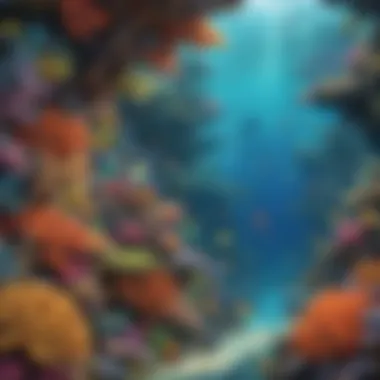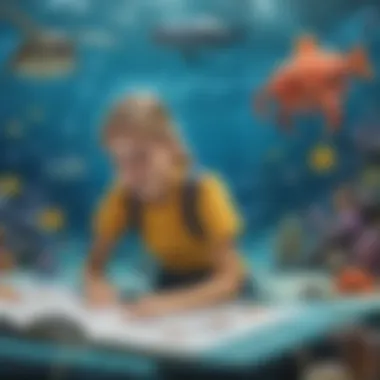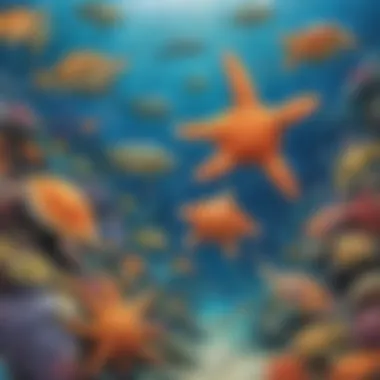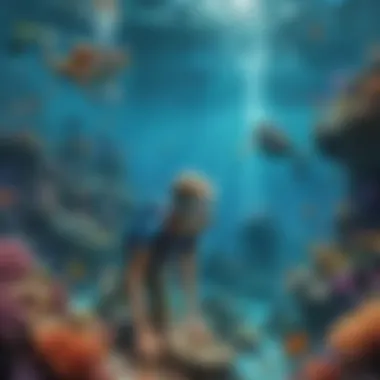Exploring Under the Sea: An Educational Adventure


Intro
Exploring the ocean offers a vast educational treasure for children. The underwater world is filled with diverse ecosystems, colorful creatures, and the mysteries of marine biology. This journey not only draws kids into nature but also enhances their learning. Educators and caregivers play a vital role in harnessing this wonder, crafting experiences that ignite curiosity and inspire understanding about the environment.
This article is designed as a comprehensive guide. It will outline interactive learning games, educational topics, tips and tricks, and creative DIY projects. Each section aims to provide practical advice and innovative ideas tailored for children aged three to twelve. Parents and educators will discover ways to engage young learners in a meaningful, interactive manner.
Interactive Learning Games
Engaging kids through play is a powerful method to foster learning. Interactive learning games related to marine biology can make the underwater world come alive for children. These games not only entertain but also educate, helping kids absorb complex concepts in an enjoyable way.
Popular Games
There are numerous educational games available that focus on marine life and ecosystems. Some noteworthy examples include:
- Marine Quest: An adventure game that teaches about various sea creatures and their habitats.
- Underwater Safari: This game allows players to explore virtual oceans while learning environmental conservation.
- Ocean Explorer: Children learn about the ocean's layers and how different animals adapt to their surroundings.
Description of Top Educational Games
Each game offers unique features, designed specifically for young learners. For instance, Marine Quest combines storytelling with educational content to create an immersive experience. Underwater Safari encourages critical thinking through problem-solving challenges. Ocean Explorer uses vibrant graphics to capture attention while delivering valuable lessons about marine ecosystems.
Benefits of Playing Educational Games for Kids' Cognitive Development
Playing these games offers several advantages:
- Enhance critical thinking and problem-solving skills.
- Boost memory and recall abilities through interactive challenges.
- Foster teamwork and cooperation in multiplayer settings.
- Stimulate creativity as children build their unique virtual worlds.
Game Reviews
In-depth reviews of selected educational games can provide insights into their effectiveness. For example, Marine Quest has been praised for its engaging narrative and rich content. Players report increased interest in marine biology after gameplay.
Comparison of Gameplay and Learning Outcomes
In comparing the gameplay and learning outcomes, it becomes clear that engaging games can significantly deepen children's understanding of marine life. Games that incorporate real-world scenarios often lead to better retention of knowledge and passion for subjects related to ecology.
Educational Topics
Exploring educational topics beyond marine biology can enrich children's understanding. This section compiles articles covering various subjects:
- Math: Learning through ocean-themed puzzles and games.
- Science: Understanding the properties of water and ocean currents.
- Languages: Exploring vocabulary related to ocean exploration.
Importance of Interdisciplinary Learning for Holistic Development
Research shows that interdisciplinary learning fosters holistic development in children. By combining different subjects through the lens of ocean exploration, kids can better relate what they know to real-world applications and develop critical life skills.
Tips and Tricks
Enhancing children's learning journey requires intentional strategies. Here are some practical tips for parents and educators:
- Make learning fun by incorporating games and activities into lessons.
- Create a dedicated space for ocean-themed activities and projects.
- Encourage children to explore marine environments, even through documentaries.
Strategies for Making Learning Fun and Engaging
Consider using storytelling, hands-on activities, and visual aids to engage children. These methods can significantly capture attention and make learning enjoyable. Allow children to take the lead and explore topics of their interest to promote a sense of ownership in their learning.
Creative DIY Projects
Hands-on learning experiences encourage creativity while teaching new skills. This section offers detailed guides for DIY projects that are ocean-themed.
Step-by-Step Guides
- Create a Coral Reef Model: Using cardboard, paint, and craft materials, children can mimic real underwater ecosystems.
- Build a Fish Mobile: Simple instructions can guide kids in creating colorful fish that sway above their beds.


Benefits of Hands-On Activities for Children's Cognitive and Motor Skills
Hands-on projects promote cognitive and motor skills by encouraging problem-solving and fine motor development. Such activities foster a love for creativity and provide opportunities for self-expression.
Craft Ideas
Exploring craft ideas using simple household items can inspire children. Projects like creating sea creature puppets from old socks or making ocean dioramas with recycled materials enhance creativity and resourcefulness.
Importance of Artistic Expression in Children's Development
Artistic expression is crucial for children's emotional and intellectual development. It allows them to convey feelings, boost confidence, and develop critical thinking through different forms of creativity.
Educators should remember that learning about the ocean can spark a lifelong passion for science and nature in children. Encouraging exploration and creativity is key to nurturing curiosity.
The Importance of Marine Education
Marine education serves as a crucial component in the overall development of young minds. As children engage with the marine world, they gain insights not only about the ocean but also about life and the environment. Understanding marine ecosystems allows kids to learn the intricacies of life beneath the waves. This education can foster respect and empathy for creatures that share our planet.
With the ocean covering over 70% of the Earth’s surface, knowledge of marine environments becomes essential. By emphasizing marine biology, we provide children with the knowledge to recognize the importance of biodiversity. This fosters curiosity and promotes a sense of stewardship for the ocean.
Educational programs can enhance cognitive skills. They encourage critical thinking when analyzing ecosystems, species, and environmental factors. Schools and caregivers have a unique opportunity to inspire the next generation of marine scientists and conservationists. Teaching kids about marine life can also be fun and captivating, making learning an enjoyable experience.
Understanding Marine Ecosystems
Marine ecosystems are incredibly diverse. They include various habitats such as coral reefs, kelp forests, and deep-sea environments. Each ecosystem plays a specific role in maintaining ecological balance.
Children learn that coral reefs, often termed the "rainforests of the sea," provide critical habitat for numerous species. These ecosystems also protect coastlines and support local fisheries. Awareness of these roles helps kids appreciate the complexity of interactions in nature.
Knowledge of marine ecosystems promotes an understanding of food webs. Kids discover how energy flows through different levels, from phytoplankton to apex predators such as sharks. Each organism contributes to the health of the environment.
By studying these ecosystems, children become aware of threats they face, such as climate change and pollution. This understanding can inspire the next generation to act on behalf of their environment.
Encouraging Environmental Awareness
Awareness of environmental issues is vital for today’s youth. Marine education plays an integral part in shaping responsible citizens. When children comprehend the challenges our oceans face, they are more likely to take meaningful actions.
For instance, by discussing plastic pollution, kids learn how human actions impact marine life. They may grasp the gravity of the situation when they see images of wildlife affected by litter.
This intersection of education and consciousness can lead to positive outcomes. Practical activities, like beach clean-ups or recycling campaigns, empower children to make a difference. They are not just observers of the issue; they can become active participants in the solution.
"Marine education opens the door to understanding; it transforms kids into advocates for the planet."
In doing so, we can nurture a generation that values the ocean and all its inhabitants. Each lesson learned can contribute to a greater commitment to sustainability.
The Ocean's Layers
Understanding the ocean's layers provides critical insight into the diverse life forms and ecosystems that thrive beneath the waves. Each layer of the ocean presents unique characteristics that influence marine life. This knowledge is particularly valuable for educators, as it lays the foundation for exploring more complex topics in marine biology and ecology. The layers of the ocean can be seen as different worlds, each with its own distinct conditions and organisms. By comprehending these layers, students can appreciate the importance of conserving vulnerable marine habitats.
Surface Zone: Sunlight and Life
The surface zone, often referred to as the photic zone, is where sunlight penetrates the water, allowing photosynthesis to occur. This zone is rich in nutrients and supports a variety of life forms, from tiny plankton to large whales. It is a dynamic area where warmth and light create a vibrant ecosystem. The abundance of life in this zone can be fascinating for kids, as it presents visible examples of marine interactions.
Educators can encourage children to observe the following aspects:
- Photosynthesis: The role of sunlight in supporting oceanic food chains.
- Marine Flora and Fauna: The diversity of species inhabiting this layer, including coral reefs and schools of fish.
- Ecosystem Interactions: How predators and prey interact in this abundant environment.
Thermocline: Temperature Transitions
Beneath the surface, the thermocline is a region marked by a stark change in temperature. As water depth increases, there is a dramatic drop in temperature. This layer acts as a barrier between the warmer surface waters and the colder depths below. Understanding the thermocline is essential for appreciating how temperature impacts marine life. Kids can explore:
- Temperature Effects: How different species adapt to varying temperatures.
- Ocean Currents: The role of thermoclines in influencing ocean currents and marine migration patterns.
- Diversity of Life: How species are distributed according to temperature, leading to unique communities in different ocean layers.
Deep Ocean: The Dark Depths


The deep ocean represents the majority of the ocean's depth and is characterized by darkness and extreme pressure. Very few organisms can thrive in this harsh environment, creating a mysterious and intriguing area for exploration. In this layer, bioluminescent creatures and large predators adapt in unique ways to survive. For young learners, the deep ocean can serve as a thrilling subject:
- Life Forms: Introduction to fascinating species like the anglerfish and giant squid.
- Survival Adaptations: How marine organisms evolve to cope with high pressure and lack of sunlight.
- Exploration: Discussing the technologies used to explore these depths, such as submersibles.
"The ocean is a world of incredible diversity, illustrating the complex interactions of life across its layers."
Engaging with these layers not only enhances knowledge of marine ecosystems but also fosters an appreciation for ocean conservation.
Types of Marine Life
Understanding the types of marine life is essential in fostering a deep respect for oceanic ecosystems. This section highlights the vast diversity that inhabits our oceans. Each category of marine life plays a crucial role in ecological balance and contributes to the intricate web of life below the surface. Teaching kids about these creatures not only sparks their curiosity but also develops a foundation of knowledge that promotes conservation efforts. Recognizing the variety ensures that young learners appreciate the complexity of marine environments.
Fish: Diversity in the Sea
Fish represent one of the most diverse groups of marine life. They vary significantly in size, shape, and color. From the tiny neon tetra to the enormous whale shark, fish adapt to a range of environments, both near the surface and in the deep ocean. Fish are vital for many marine ecosystems as they contribute to the food web.
Some key points about fish include:
- Habitats: Fish can be found in every ocean habitat, including coral reefs, kelp forests, and the deep sea.
- Adaptations: Many fish have special adaptations, such as bioluminescence in deep-sea species which helps them communicate or camouflage.
- Reproduction: Most fish reproduce via spawning, where eggs and sperm are released into the water, ensuring a broad distribution of their offspring.
Mollusks: The Shell-Bearing Creatures
Mollusks are another interesting category of marine life. This group includes snails, clams, and octopuses, all of which have unique characteristics that make them fascinating. Most mollusks have a soft body, and many are protected by a hard shell. They serve as food for various marine mammals and help keep their ecosystems balanced.
Important aspects of mollusks:
- Diversity: There are over 85,000 known species of mollusks, each with distinct adaptations.
- Feeding Habits: Many mollusks, such as bivalves, filter feed, helping maintain water quality.
- Intelligence: Some, like octopuses, exhibit remarkable intelligence and problem-solving abilities.
Invertebrates: Life Without a Backbone
Invertebrates are critical to marine ecosystems. These creatures do not possess a backbone but come in various forms. This category includes jellyfish, sponges, sea cucumbers, and crustaceans. Their roles in the ocean are varied and important.
Key highlights about invertebrates:
- Ecosystem Roles: Invertebrates play essential roles as decomposers and prey for many larger creatures.
- Habitat Structure: Coral reefs, built by colonies of specialized invertebrates, provide essential habitats for countless marine species.
- Reproductive Strategies: Invertebrates often have diverse reproductive strategies, enhancing their survival and adaptation to different environments.
Marine Mammals: Intelligent Adaptations
Marine mammals, including dolphins, whales, and seals, are remarkable animals that have adapted to life in the water. They are known for their intelligence and complex social structures. Marine mammals often serve as indicators of ocean health due to their position at the top of the food chain.
Significant points about marine mammals:
- Social Behavior: Many marine mammals live in pods or groups, exhibiting cooperation and communication.
- Adaptations: Structures like blubber and sleek body shapes are essential adaptations for life in aquatic environments.
- Conservation Concerns: Threats like pollution, overfishing, and climate change are pressing issues that impact their survival.
Understanding these types of marine life is essential for educating young people about their ocean environment and the necessity of preserving it.
Interactive Learning Activities
Interactive learning activities are essential to engaging children during marine education. They inspire curiosity and creativity while reinforcing concepts from marine biology. By participating in hands-on projects, kids not only understand marine ecosystems better but also develop critical thinking skills. These activities serve as a bridge between theoretical knowledge and real-world application. Introducing fun and informative tasks allows educators to capture young minds.
Crafts: Building Undersea Models
Crafts are an enjoyable way for children to express their understanding of marine life. Building undersea models encourages imaginative thinking and fine motor skills. Projects may include creating models of coral reefs, building clay representations of sea animals, or crafting 3D ocean scenes using recycled materials. This not only nurtures creativity but also teaches about marine habitats and species diversity.
When guiding kids through these craft projects, educators should consider the following:
- Materials: Use safe, easily available materials. Items like colored paper, clay, and paint work well.
- Instructions: Provide step-by-step guidance, making it easy to follow.
- Discussion: After completing a craft, hold a short discussion. Ask kids what they made and how it relates to marine life.
These discussions encourage sharing of knowledge and insights. Crafting can effectively promote cooperative learning, as children often work better in groups, drawing inspiration from each other.
Games: Engaging with Marine Life


Games provide a dynamic approach to learning about marine life. Educational games can take many forms, from board games centered on ocean conservation to digital apps that simulate marine ecosystems. Through gameplay, children learn about various species and their behaviors while having fun.
Consider these options for engaging games:
- Matching Games: Create cards featuring different marine creatures. Kids can learn to identify and associate each creature with its habitat or role in the marine ecosystem.
- Scavenger Hunts: Organize a scavenger hunt with marine-themed items. This activity involves exploration and can teach children about different species and their environments.
- Role-playing Games: Encourage kids to take on the roles of marine animals. They can act out behaviors or simulate interactions within an ecosystem.
Such games reinforce knowledge while enhancing memory retention. Making learning enjoyable is efficient in boosting motivation and participation among students.
Understanding Ocean Conservation
Understanding ocean conservation is crucial in a world where marine ecosystems face unprecedented challenges. Educating young learners about the importance of taking care of our oceans goes beyond science; it encompasses critical thinking, responsibility, and empathy towards our planet. The oceans play a vital role in regulating climate, providing food, and maintaining biodiversity. By understanding conservation, children can develop a sense of ownership over their environment.
Marine conservation is not static; it evolves as we learn more about the oceans. Teaching kids about this topic instills long-term thinking. Awareness can lead to advocacy for initiatives aimed at protecting marine life. Furthermore, conservation education can inspire future scientists, researchers, and environmental leaders. Through their engagement with these concepts, kids cultivate critical skills in problem-solving and collaboration.
Threats to Marine Life
The ocean hosts incredible biodiversity, yet it is under constant threat. Some of the main threats to marine life include pollution, overfishing, climate change, and habitat destruction.
- Pollution: Plastics and chemicals find their way into the ocean and harm marine organisms.
- Overfishing: Many fish populations are declining due to unsustainable fishing practices. This affects not just fish but the entire ecosystem.
- Climate Change: Rising ocean temperatures and ocean acidification impact coral reefs and other marine habitats.
- Habitat Destruction: Coastal development and illegal dumping lead to the loss of critical habitats like mangroves and seagrasses.
"Understanding the threats that marine life faces is the first step in fostering a sense of responsibility and advocacy in young learners."
Being aware of these threats motivates kids to participate in conservation efforts. Simple actions, such as reducing plastic use and learning about sustainable fish options, can have significant impacts.
Sustainable Practices for Kids
Engaging children in sustainable practices is essential in fostering a responsible future generation. Simple yet effective actions can encourage kids to participate actively in ocean conservation.
- Reduce, Reuse, Recycle: Teach kids the importance of minimizing waste. Simple actions, like using reusable bags and containers, can help reduce ocean pollution.
- Conserve Water: Encourage children to save water at home. Simple habits like turning off the tap while brushing teeth can collectively lead to major savings.
- Support Sustainable Seafood: Educate children on choosing seafood from sustainable sources. Apps and guides can help identify responsible options.
- Participate in Clean-ups: Get kids involved in local beach clean-up events. This hands-on experience shows them the impact of pollution.
By adopting these practices, children can see their individual efforts contributing to the broader goals of ocean conservation. It empowers them and reinforces the idea that everyone can play a role in protecting our planet.
Useful Resources for Educators
The role of useful resources is paramount in enhancing marine education for children. Educators, parents, and caregivers can find immense value in curated materials that both inform and inspire young learners. Effective resources can help transform complex marine biology concepts into engaging lessons, stimulating curiosity about the underwater world.
Having access to a variety of educational tools expands the scope for interactive learning. By integrating different mediums, such as books and websites, learners can explore marine life in depth. This dual approach not only reinforces knowledge but also caters to different learning styles, making the information more accessible and engaging.
Books on Marine Biology
Books serve as a fundamental resource for exploring marine biology. They offer structured information and can be a great starting point for understanding the ocean's complexities. Here are some recommended titles:
- "Ocean: A Visual Encyclopedia" by DK Publishing
- "The Sea Book" by Charlotte Milner
- "The Fascinating Ocean" by several authors
- "Coral Reefs: A Very Short Introduction" by Charles Sheppard
These books are tailored for young audiences, usually featuring colorful illustrations and engaging text. They cover topics ranging from ocean ecosystems to the variety of marine animals. Additionally, they often include fun facts, quizzes, and interactive elements. This engagement encourages exploration beyond the page, fostering a deep and lasting interest in marine life.
When selecting books, consider the age-appropriateness and the specific interests of the child. Educational books can serve as references, enriching the learning experience during marine-themed activities and discussions.
Websites for Further Research
The internet is a treasure trove of information for marine education. Various educational websites offer interactive experiences, real-time data, and extensive resources. Here are some notable sites:
- National Geographic Kids: Provides articles, videos, and games about marine life and ecosystems.
- Ocean Conservancy: Offers resources on conservation and the importance of protecting marine environments.
- NOAA's Ocean Explorer: Features expedition reports and educational materials about ocean exploration.
- MarineBio.org: Dedicated to marine life research and education, providing facts and conservation information.
These websites are dynamic tools for educators. They not only furnish essential knowledge but also provide visuals and multimedia that engage children in learning about marine environments. Regularly updated content ensures that users have access to the latest scientific discoveries and conservation news.
Summarizing, utilizing diverse resources is essential in marine education. Books provide depth and structure while websites facilitate interactive exploration. Together, they equip educators with the tools needed to inspire the next generation of ocean advocates.
Epilogue: Fostering a Love for the Ocean
Encouraging a fascination with the ocean is vital. This conclusion encapsulates the essence of marine education as presented throughout the article. By fostering a love for the ocean, children can develop a genuine appreciation for marine life and ecosystems. This appreciation paves the way for future conservation efforts, ensuring the protection of our underwater world.
The ocean is not just a vast body of water; it is a complex ecosystem filled with extraordinary creatures and plants. Engaging children with interactive learning experiences, such as crafts, games, and stories about marine life, cultivates curiosity. When children explore the ocean, they gain knowledge that lasts a lifetime. They learn about various species and their unique adaptations, fostering critical thinking and empathy for living beings.
Key Benefits of Fostering Love for the Ocean:
- Environmental Awareness: Understanding marine ecosystems helps children grasp the importance of conservation. It sparks their interest in protecting endangered species and habitats.
- Sustainable Practices: Children who learn about the ocean often practice sustainable living. They understand how their actions impact the environment, encouraging them to reduce waste and become eco-conscious.
- Connection with Nature: Engaging with marine life promotes a connection to nature. This bond encourages outdoor activities and exploration, which are critical for healthy development.
- Lifelong Learning: A love for the ocean encourages ongoing learning. Children are likely to pursue marine biology or environmental science, leading to careers dedicated to ocean conservation.
"Education is the passport to the future, for tomorrow belongs to those who prepare for it today."















